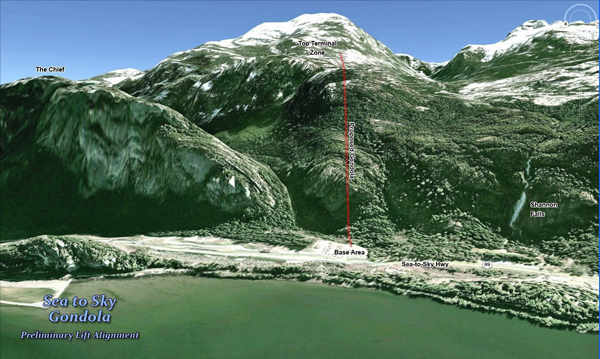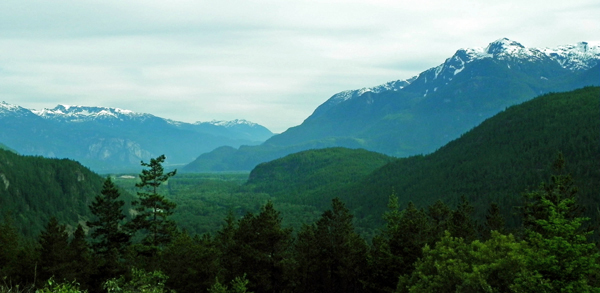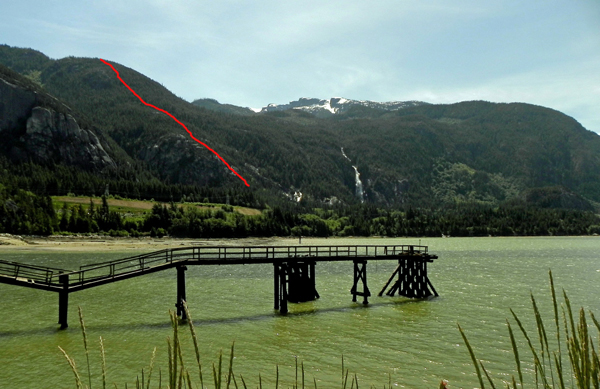Like most residents of the Squamish area in western B.C., Viona Falk has watched the gondola development story explode with interest over the last few months. Like them, she has her own opinion on the matter.
What makes Falk different -- besides her light pink cat's-eye spectacle frames and love of good old-fashioned handwriting -- is that she has never hiked in the Stawamus Chief Provincial Park. She has never seen the startling blue of Howe Sound from the top of the giant granite monolith, the proud Chief.
Because of her disability, she never will. But she's okay with that. Falk opposes the gondola development, even if it would be her only way up the mountains in the park.
"I think it has to be a person with a disability who questions the idea that this area becoming accessible is such a great thing," Falk told me over coffee at the Onatah Coffee café in Garibaldi Heights, just five minutes north of Squamish. "I personally don't want my disability being used as an excuse for destroying part of an area that is parkland and a natural area."
The proposed project would place seven gondola towers up the mountain between Shannon Falls and the Chief to a terminal station outside the park. It's well on its way, with legislation recently passed that changes the boundaries of the park and removes a strip of land through it where the towers would be built.
Proponents argue that a gondola will alleviate stress on the over-used trails up the Chief, bring economic benefits to Squamish through job creation and tourism, and increase the area's accessibility for people who, like Falk, couldn't otherwise hike through the park. The company behind the project, Sea to Sky Gondola, has already garnered support from the Ministry of Environment and the municipal government of Squamish.
But critics say the economic benefits are subjective and possibly overblown, the process to reclassify the land was conducted without a proper public review process, the project goes against the park's strategic management plan, and the major voices fighting for accessibility are the proponents, not the disability advocacy groups themselves.
This reporter came to the Squamish area to learn more about what's at stake for the region. My trip took me from the coffee shop where I met Falk, to the mayor's office in downtown Squamish, and finally all the way past Shannon Falls up the trail that might one day be crossed over by shiny new gondola cars bringing visitors to the ridge leading to Mount Habrich.
Question of benefit
Sea to Sky Gondola general manager Jayson Faulkner says the gondola project will help adjust Squamish's economic base from industrial to tourism, which he says the community has had a "somewhat difficult time" doing. According to Faulkner, the project will generate 30 to 80 long-term jobs.
Mayor Rob Kirkham of Squamish thinks the greatest economic benefit will come from attracting more people to the area.

"Jobs are a part of it, but more than the number of jobs that are generated on the site is the draw and the spin-off to the economy and to employment in the tourism sector of our economy," he said.
With other gondola ride opportunities close by however, some critics question whether such economic benefits will materialize. Former city councillor of Squamish Meg Fellowes says the gondola faces a competitive marketplace.
"I just question how successful this could be given that Whistler is just up the road and Vancouver has a similar facility in Grouse Mountain," said Fellowes.
Sea to Sky Gondola's website doesn't yet provide a business plan.
"I haven't seen a business plan, so whether they can get financing for it is a question," Fellowes said.
Moving boundaries
After reviewing Sea to Sky Gondola's application, the B.C. Ministry of Environment approved a plan to remove a strip of land out of the Stawamus Chief Provincial Park and redraw the park's boundaries to exclude that land, reclassifying it as "protected" rather than Class A parkland.
The ministry sent its recommendation to the B.C. Legislature, which passed the act removing the parkland on May 31.
Faulkner says the company held over 100 open house events throughout the community of Squamish to collect public feedback, but to organizations like the Canadian Parks and Wilderness Society (CPAWS) and the Outdoor Recreation Council of BC (ORC), that process wasn't good enough to justify the removal of parkland.

CPAWS director of conservation Chloe O'Loughlin said that since it takes years to establish a provincial park, any boundary changes need to have "equally serious" public consultation.
But Faulkner says that the process has been among the "most rigorous" he's ever seen a project go through.
"BC Parks has been extraordinary in their thoroughness on this," Faulkner said. "I would only hope the pipeline would get the same kind of review this project has had."
According to executive director Jeremy McCall, the ORC passed an internal resolution on June 9 to change the park boundary adjustment policy and sent it to the Ministry of Environment, stating that public reviews should be "comparable to the level of consultation employed in the park establishment and management process."
The ORC resolution also calls for a change in policy which would require BC Parks to organize public open houses and meetings, instead of leaving the responsibility to project proponents. In a statement emailed to The Tyee, The Sierra Club of BC also called for a public review process led by BC Parks.
Minister of Environment Terry Lake said that though BC Parks doesn't conduct the public consultations, they do monitor them and evaluate feedback.
Friends of the Squamish Chief (FOSC), an ad hoc group formed to fight the gondola development, sent a letter to the ministry on June 13 which included a petition with over 800 signatures expressing opposition to the project. Member Anders Ourom thinks BC Parks should play a more direct role in the process to change park boundaries.
"BC Parks should be acting as a protector of parks rather than a facilitator of development in parks," Ourom said.
According to Ourom, if BC Parks were the driving force behind the open house process, people would have the confidence that the information presented was accurate. The ministry's support of the project sets a "risky precedent" for the future development of provincial parks, he says.
Fellowes, also a member of FOSC, says that since provincial parks are "provincial, national, international icons, not just local ones," a province-wide review process is important.
Minister Lake thinks that while a province-wide review process might be necessary in some situations, it isn't in this case.
"If the values that park had in its park management plan were inconsistent with the proposal, then I think it's a different story. Here we've got a proposal this is consistent with the values in the park management plan," Lake said, referring to the strategic plan that was created when the park was formed 20 years ago.
"So we don't think that you need to go to province-wide consultation on that."
Lake called the claims that BC Parks is setting a precedent for industrializing provincial parks "just bologna." He said that allowing the gondola project to proceed doesn’t mean "we're going to do this in every park across British Columbia," but that when opportunities to enhance recreation are consistent with the park’s management plan, BC Parks will support them.
"Does taking the land out of the park... fit in with the strategic plan for the park in terms of recreational values and other values that are part of the plan? The answer in this case is yes," Lake said.
Park's plan contested
Though Lake repeatedly emphasizes the project's consistency with the park's management plan, Ourom claims the proposal is actually contrary to that plan. Ourom says he was involved with the study team that led to the original creation of the park in 1997.
While the team was creating the master plan, someone actually mentioned there are "gondolas on things like this in Europe," and that the team might want to consider allowing for a similar development in Stawamus Chief park, Ourom said.
That idea was "turned down without much discussion."
The management plan's Visitor Services section describes one of its major themes as providing "non-mechanized recreation opportunities" for visitors to experience the park. Ourom points to that line (at the top of page 32 of the document) as proof that the gondola proposal goes against the master plan of the park.
Minister Lake, however, is focusing on the main goals outlined in the plan. He says there are different types of parks under the management of the province, and while some are mainly for conservation, the Stawamus Chief Management Plan lists recreation as one of its main values.
"This is a park that has recreation high on its goals," Lake said.
Accessibility: goal or rhetoric?
Along with the economic benefits, gondola proponents have been hailing the project as an opportunity to provide accessibility for people who could not otherwise hike in the area.
Lake thinks this is one of the most important aspects of the project. He said that though he hasn't heard from any people with limited mobility about this project specifically, the gondola proposal fits into his goal of making parks more accessible to people with mobility challenges.
"If you're in a wheelchair or if you're older and you can't hike that trail, now you have an opportunity to access the views and the splendor that otherwise you wouldn't have access to," he said.
Faulkner thinks helping as many people as possible experience wilderness areas will help them "see a value in preservation" which will help further conservation efforts.
"If you want to protect wild places, you have to do so with a measured responsibility of getting people to understand why they are important to protect in the first place," he said.
The BC Coalition of People with Disabilities told The Tyee they don't have an official opinion about the project, but volunteer Tom McGregor, who runs a blog called AccessEco BC which showcases accessible tourist hotspots for people travelling in B.C., thinks the gondola would "definitely" bring many people with disabilities to the Squamish area.
"Our whole province is actually attracting more and more tourism from people with disabilities," he said. "I think it would be, if not a stopping point on the way to Whistler, a destination itself."
But in my coffee shop conversation with Falk, a wilderness lover, she says all the proponents' talk about accessibility is just "self-serving rhetoric that makes it sound like they are interested in people when they are really only interested in profit."
Falk thinks the gondola would detract from the appeal of the Squamish area, and she wrote a letter to the Squamish Chief explaining her position.
"I think that this is basically Disney-fication of the area. And unfortunately I think it would sort of take away from what makes Squamish special," she said. "I think it's special because it's kind of rugged around the edges."
She sees a disturbing trend in what many see as an innocent recreational development.
"It distresses me how that's part of a trend on the part of all levels of government in Canada, who seem to think that everything is for sale," she said. "And I disagree with that."
Sea to Sky Gondola has now received the zoning approval it needs in order to build the terminus station, but once the boundary changes take effect, BC Parks is not obligated to give the company the necessary park use permit.
Opponents of the project are set to continue fighting the proposal, but Sea to Sky hopes to obtain the use permit and begin construction by August. ![]()
Read more: Local Economy, Labour + Industry, Environment















Tyee Commenting Guidelines
Comments that violate guidelines risk being deleted, and violations may result in a temporary or permanent user ban. Maintain the spirit of good conversation to stay in the discussion.
*Please note The Tyee is not a forum for spreading misinformation about COVID-19, denying its existence or minimizing its risk to public health.
Do:
Do not: